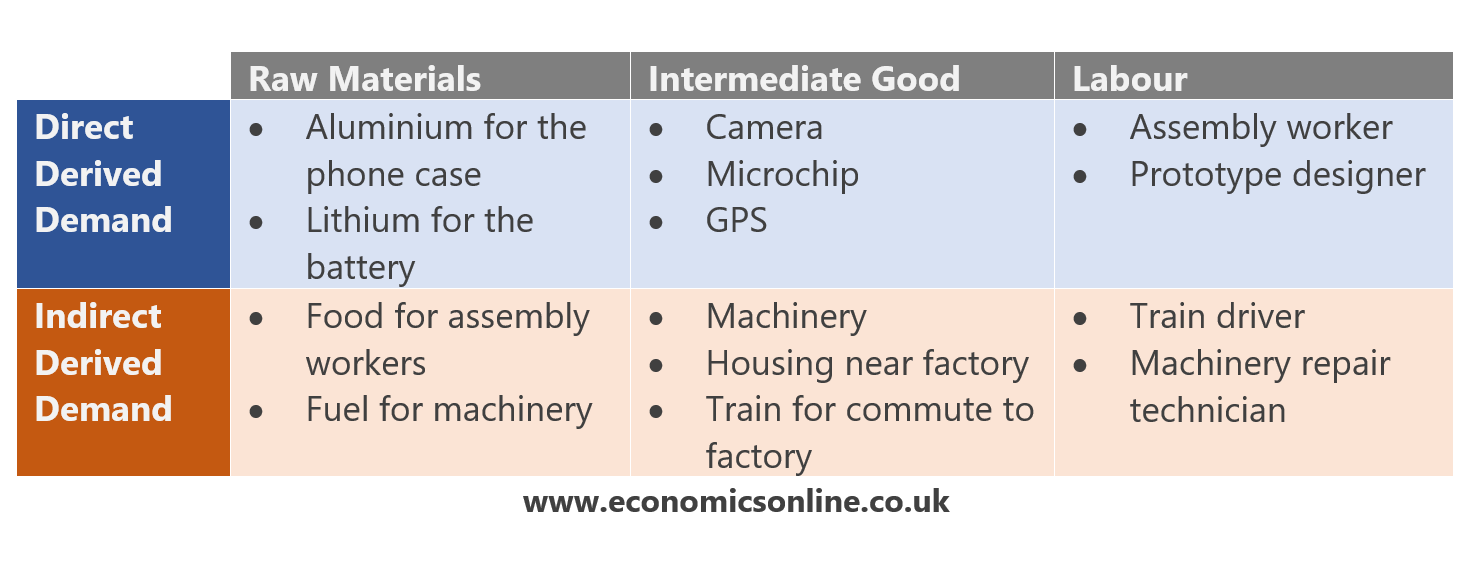
What is Derived Demand?
Derived demand refers to the demand for a good or service that arises from its association as an input in the production of another final good. These factors of production are not directly demanded by consumers in and of themselves. However, without them, the final goods that are demanded by consumers would not exist. Demand for the input good is entirely derived from the demand for the final good.
Understanding Derived Demand
Derived demand goods can be broadly broken down into three groups:
1. Raw materials: Primary, unprocessed materials that occur naturally. Such materials are mined, grown, fished or otherwise collected for either immediate consumption, or as an intermediate input of another good. Examples of raw materials include aluminium, crude oil, oak, beef and oranges.
2. Intermediate goods: Although not meeting the definition of a raw material, intermediate goods are not demanded for final use by consumers. These goods are themselves created, refined or processed from other input goods and/or labour, for use as an input in the production of another good. Examples of intermediate goods include car tyres, computer microchips, fabrics, heavy machinery and wheat.
3. Labour: Physical or mental energy exerted by individuals as part of a goods production process. An example is a lummberjack that swings the axe to cut down a tree, a mechanic that changes a car’s engine or an engineer that designs a phone prototype.
Note that not all demand for raw materials or labour is derived demand. There are many instances where these are final goods, such as an apple, or work completed by a defence lawyer. It is important to remember that derived demand is only the portion of total demand for the good that is used in the production of another good.
In many cases, several stages of intermediate good production are required to create the final good. To create a smartphone, one must first create components such as the camera, microchip and Bluetooth receiver. Creating the camera requires first creating the lens, flash and autozoom functions. Creating the lens requires the melting of sand, ash and limestone to form glass, which must then be shaped into the desired shape and convexity. This procession of intermediate production phases is called the chain of derived demand, with input goods for each phase deriving their demand from the final good, in this case a smartphone.
Direct Versus Indirect Derived Demand
Derived demand goods can be further broken down by whether they directly or indirectly contribute to the production of the final good. A good is considered to directly contribute to production if it is either a raw material that forms part of the final good or directly manipulates the raw materials making up the final good.
For example, the microchip in a smartphone has direct derived demand since it makes up part of the smartphone. The fuel used to power the machinery that makes the microchip has indirect derived demand since it does not directly manipulate the final good, but supports production such that the final good could not exist without it.

Distinction From Joint Demand
If two goods are complementary, an increase in demand for one will come with a joint increase in demand for its complementary pair. For example, an increase in demand for TVs will result in higher demand for TV remotes, as one is useless without the other. This should not be confused with derived demand, as the remote does not act as an input in the production of a TV.
Benefits of Understanding Derived Demand
A strong understanding of the production process for various final goods, and the derived demands for the associated input goods can be beneficial for many reasons. As demand for the final good shifts up or down, individuals familiar with their production process may be able to foresee the direction and magnitude of the corresponding shifts in derived demands for the inputs.
During the 1848-55 Californian Gold Rush, a group of savvy merchants saw the opportunity ton respond to the influx of gold mining in the area by selling mining tools. Many historians believe that this strategy proved much more profitable than actually participating in gold mining. The “pick and shovel” investment strategy was subsequently used to describe the tactic of investing in the input goods of a final good that is experiencing an upward shift in demand.
Business owners whose products experience an upward shift in demand may respond by vertically integrating their supply chain to guarantee input supply. Reducing the ability of upstream manufacturers to profit from the associated upward shift in derived demand. As an example, Apple vertically integrated much of its supply chain to, amongst other things, guarantee its supply of lithium. A key input good of electronic devices that experienced a large upward shift in derived demand with the advent of smartphone technology.
Economic Effects of Derived Demand
In today’s interconnected and technologically advanced economy, the effects of fluctuations in derived demand for a particular input good can be difficult to isolate. Production processes are becoming increasingly complex, and many raw materials are used for a multitude of final goods, making derived demand effects for each difficult to isolate. Where the use of an input good is dominated by one final good, such as lithium in batteries, derived demand effects are easy to see. But this is becoming increasingly rare.
Derived demand effects are more easily isolated if the production of a specific good is concentrated in one geographic area. Post-WWII saw a surge in demand for U.S. automobiles, with production concentrated around Detroit, Michigan. As the industry boomed in the 1950s, mass migration into the city followed the demand for factory workers. New houses, schools and transport infrastructure were created to accommodate the influx of workers, paid for by wages from major car manufacturers such as General Motors and Ford.
During the 1970s, consumer preferences shifted towards importing foreign cars and demand for U.S. vehicles declined. Factories in Detroit began to close and mass layoffs of factory workers meant that the tax base in the city was eroded. Demand for local housing evaporated as workers found opportunities in other cities, resulting in plummeting property values and vacant houses. In July 2013 Detroit became the largest U.S. city to file for bankruptcy, and public safety issues were raised after the local government could not afford to cover the cost of street lighting.
Summary
Demand for goods to be used in the production process of a final good are said to have derived demand since they are not used for final consumption. These can be grouped into three types:
1. Raw materials
2. Intermediate goods
3. Labour
If the input good itself forms part of the raw material used in the final good, or directly manipulates the raw material in the final good, it is said to have direct derived demand. If the input good merely supports the production of the final good, it is said to have indirect derived demand.


